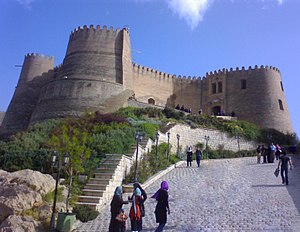Falak-ol-Aflak
| Falak-ol-Aflak Castle | |
|---|---|
| دژ شاپورخواست | |
 |
|
| General information | |
| Type | fortress |
| Location | Khoramabad, Luristan |
| Coordinates | 33°29′02″N 48°21′12″E / 33.483787°N 48.353426°ECoordinates: 33°29′02″N 48°21′12″E / 33.483787°N 48.353426°E |
Falak-ol-Aflak Castle (in Persian: دژ شاپورخواست Dež-e Shāpūr-Khwāst, in ancient times known as Dežbār as well as Shāpūr-Khwāst) is a castle situated on the top of a large hill with the same name within the city of Khorramabad, the regional capital of Lorestan province, Iran. This gigantic structure was built during the Sassanid era (224–651).
The Khoramabad River runs past the eastern and south-western side of the Falak-ol-Aflak hill providing the fortress some natural protection on those sides. Today, the western and northern sides of the hill are bordered by the residential districts of Khorramabad.
Falak-ol-Aflak castle is amongst the most important structures built during the Sassanid era. It has been known by a number of names since it was built over 1800 years ago. Recorded names have referred to it as Shapur-Khast or Sabr-Khast fortress, Dezbaz, Khoramabad castle, and ultimately the Falak-ol-Aflak Castle.
Under the Pahlavi dynasty, after being used as a prison until 1968, it was transformed into a museum complex.
The foundations of the actual castle measure approximately 300 by 400 metres (980 ft × 1,310 ft). The height of the entire structure, including the hill, reaches to 40 meters above the surrounding area.
The castle itself covers an area of 5,300 square metres (57,000 sq ft). The perimeter extends for 2,860 metres (9,380 ft) in perimeter and its tallest wall is 22.5 metres high. This space is divided into four large halls, and their associated rooms and corridors. The rooms all surround two courtyards with the following measurements: the first courtyard measures 31 by 22.5 metres (102 ft × 74 ft) and the second 29 by 21 metres (95 ft × 69 ft). When originally built the castle used to have 12 towers, but only eight remain standing today.
The building's entrance is situated towards the north, within the body of the northwestern tower.
...
Wikipedia
